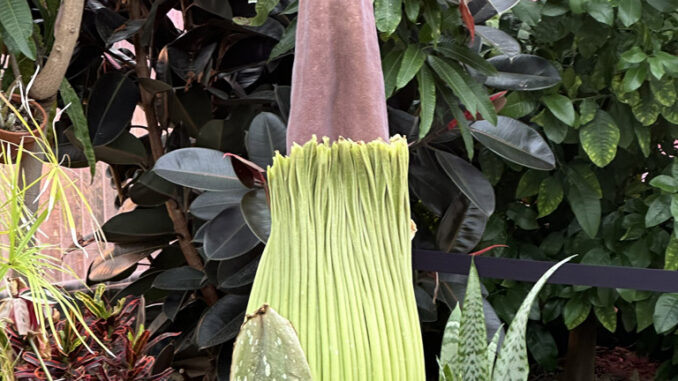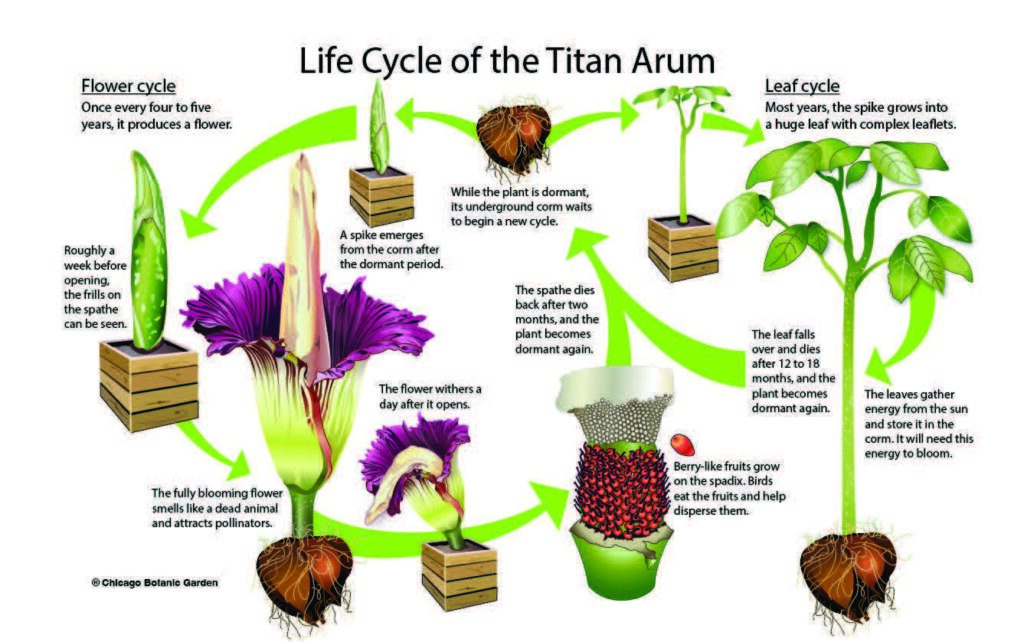
By Allison Sylte | the SOURCE
Back in 2016, Colorado State University Plant Growth Facilities Manager Tammy Brenner brought back what might be the coolest piece of conference swag ever: a corpse flower named Cosmo.
Now, after more than seven years of care in the College of Agricultural Sciences’ Conservatory, it’s slated to bloom for the first time in its life sometime around Memorial Day weekend.
“Cosmo came out of dormancy around three weeks ago, and we didn’t expect anything exciting,” Brenner said. “But then two weeks ago, it started looking a little bit more full, a little bit more plump. It started growing and shooting out stalks, and we realized something really big was about to happen.”
It grew more than 5 inches the weekend of May 18-19, and Brenner has been in contact with colleagues from across the country for advice about what to expect. She said all signs point to a bloom sometime around the holiday, although the exact date isn’t certain. When the bloom does happen, Cosmo will emit a putrid odor that has been compared to the smell of decaying flesh. This will become less pronounced after the first 12-24 hours, and the bloom itself will only last for around two to three days.
After that, Cosmo the corpse flower won’t bloom again for another three to five years.
“This is a rare occasion and a big deal because it will be the first bloom for the corpse flower here at CSU,” Brenner said.
It’s a key piece of the network of 11 Agricultural Experiment Stations scattered across the state, and the starting point for research around vital Colorado crops like corn, hemp, sorghum and wheat.
In addition to being home to numerous research operations, Brenner said the PGF Conservatory is truly a place for the community to enjoy, hosting everything from painting and drawing classes to writing workshops. It’s home to an assortment of plants that aren’t typically seen in Colorado, ranging from banana and pomegranate trees to lush ferns to multiple desert plants.
“A lot of our international students get really excited to be here because some of our plants make them feel like they’re at home,” Brenner said.
The conservatory is typically open from around 8:30 a.m. to 4 p.m. during the week and has numerous tables and chairs that allow people to take in the sights and enjoy this hidden gem year-round.
The Plant Growth Facilities team is asking for support to purchase new lighting for their facility so it can continue to be a resource to the public and advance important research.
All gifts to this project benefit the CSU-Agricultural Experiment Station Enrichment fund: col.st/h9X8W.
Support Northern Colorado Journalism
Show your support for North Forty News by helping us produce more content. It's a kind and simple gesture that will help us continue to bring more content to you.
BONUS - Donors get a link in their receipt to sign up for our once-per-week instant text messaging alert. Get your e-copy of North Forty News the moment it is released!
Click to Donate

